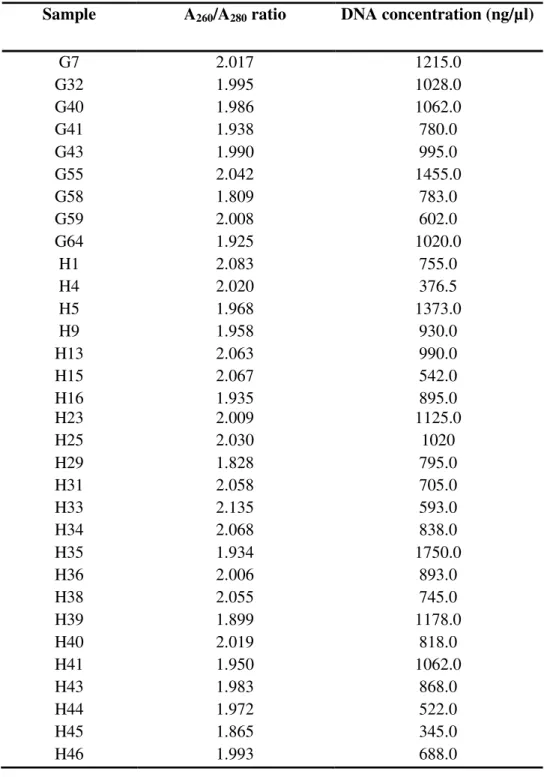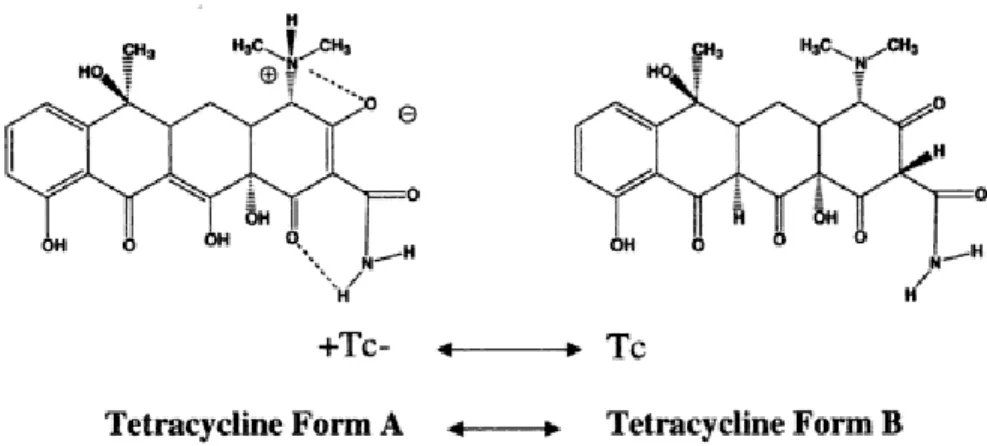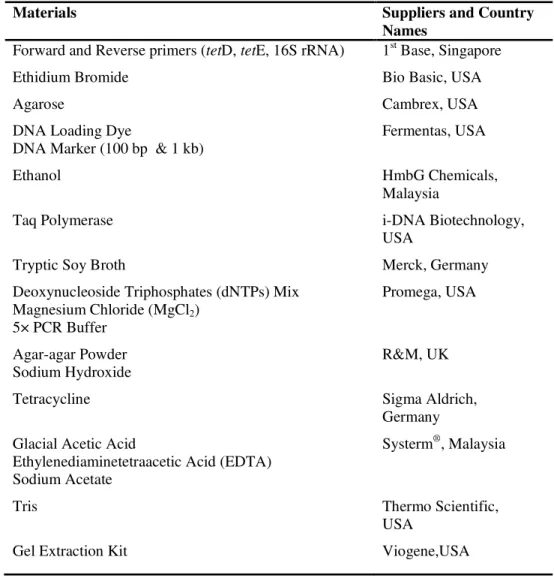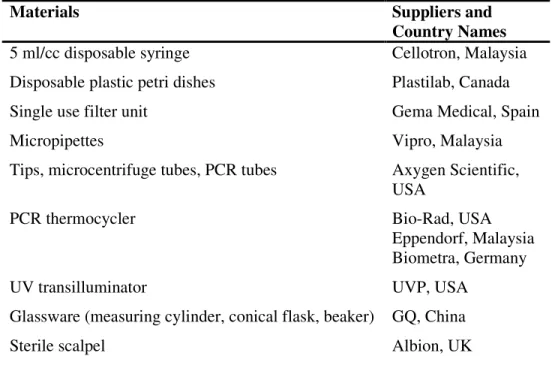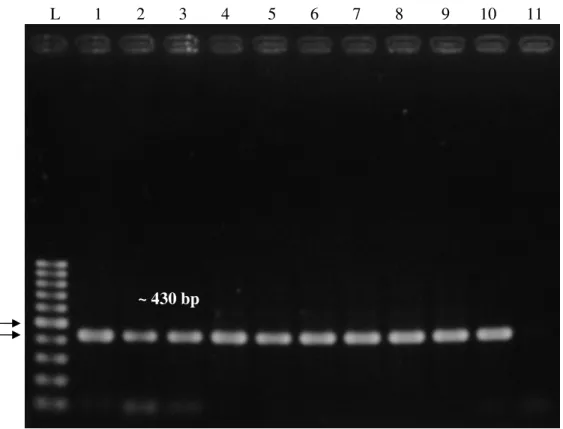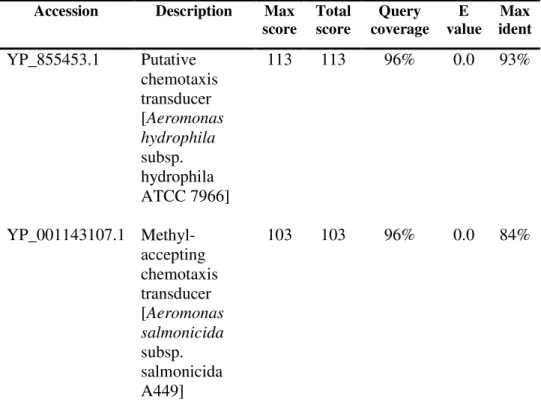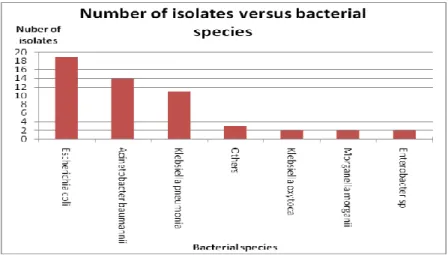PCR amplification of the 16S rRNA gene was performed to determine the integrity of the extracted DNA. Nevertheless, this study failed to detect tetE in any of the isolates examined. In conclusion, the narrow distribution of tetD among different species of Gram-negative bacteria observed in this study suggests that the isolates may carry one of the other known or novel tet genes.
This project report entitled "DISTRIBUTION OF THE TETRACYCLINE GENES tetD AND tetE IN TETRACYCLINE-RESISTANT CLINICAL ISOLATES FROM MALAYSIAN HOSPITALS" was prepared by LIM SZE YEE and submitted in partial fulfillment of the requirements for the degree of Bachelor of Science (Hons) Biomedical Science. Universiti Tunku Abdul Rahman. It is hereby certified that LIM SZE YEE (ID No: 08ADB03611) has completed this last year's project entitled "DISTRIBUTION OF THE TETRACYCLINE GENES tetD AND tetE IN TETRACYCLINE-RESISTANT CLINICAL ISOLATES FROM MALAYSIAN HOSPITALS" under the supervision of Dr.
Tetracycline antibiotics .1 Overview
- Mode of action
- Administration and dosage
- Adverse effects
- Applications
- Human therapy and prophylactic uses
- Veterinary medicine
- Active Efflux
- Ribosomal protection
- Enzymatic activation
Many problems arise from the antibiotic resistance, such as prolonged hospital stays, increased the financial burden of the patient and increased the selective pressure for resistance to emerge among pathogens (Alanis, 2005). Three different bacterial strategies of resistance have been described, which include reduction of the tetracycline intercellular concentration (active efflux), protection of the ribosome as the antibiotic target (ribosomal protection) and antibiotic inactivation by the modification of enzymes (enzymatic inactivation) (Michalova et al. , 2004; Schnappinger & Hillen, 1996). Efflux proteins act by exporting tetracycline from the cells, thus reducing the intercellular concentration of drugs and protecting the bacterial ribosome in vivo.
Without the presence of tetracycline, the repressor protein binds to the structural leak gene operator and therefore inhibits its transcription and translation. On the other hand, when the tetracycline-cation complex in the cell binds to the repressor, it would induce conformational changes of the repressor, resulting in the release of the repressor from the operator and then allowing transcription and translation of the structural leak gene. The repressor binds again to the operator when there is a decrease in the intracellular amount of tetracycline (Michalova et al., 2004).
This mechanism of tetracycline resistance was first discovered in Streptococci and appears to be more abundant in gram-positive organisms (Aarestrup, 2006; Bryan et al., 2004). The ribosomal protection proteins interact with the ribosome giving rise to an allosteric disruption of the primary tetracycline binding site(s). These two proteins appear to release tetracycline from the ribosome, thereby inhibiting the effect of the drug and allowing protein synthesis to continue (Connell, Tracz, Nierhaus, & Taylor, 2003).
The tetX, tet37 and tet34 genes are the only three examples of tetracycline resistance due to enzymatic modification and antibiotic inactivation.
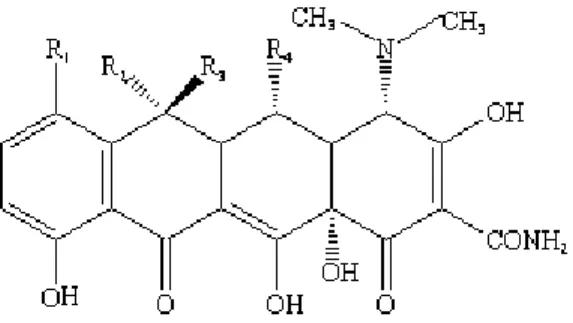
Nomenclature of tetracycline resistance genes
Their wide distribution among bacterial species is often associated with conjugative or mobile elements, for example transposons, plasmids and integrons (Alanis, 2005; Bryan et al., 2004). The gram-negative tet efflux genes are found on transposons inserted into different groups of plasmids from a variety of incompatible groups, while gram-positive efflux genes are found to be associated with small plasmids. Nevertheless, no tet genes have yet been found within integrons, although integrons have been identified in gram-negative genera and Staphylococcus species (Roberts, 2005).
To overcome worsening bacterial resistance to earlier tetracyclines, a new drug, tigecycline, was introduced after it was approved by the FDA to treat various bacterial infections in 2005. Tigecycline not only exhibits the same mode of action as typical tetracyclines, but It is also unaffected by the two main mechanisms of tetracycline resistance, which are active efflux and ribosomal defense mechanisms. This drug can now be used to treat diseases such as complicated skin and skin structure infections, as well as complicated intra-abdominal infections caused by various microbes.
Tetracycline resistance in Malaysia to date
From the results, apart from being equally resistant to kanamycin and tetracycline (81.4%), the isolates also showed the highest resistance to these two antibiotics compared to other antimicrobial agents. In another study, Tan, Haresh, Chai and Son, in 2009, tested 50 Campylobacter jejuni isolates collected from sushi from different supermarkets in Malaysia for their susceptibility to antibiotics also through the Kirby-Bauer assay. They found that there was only a low rate of resistance to tetracycline (6%) in the 50 Campylobacter jejuni isolates.
Last but not least, in 2010, Douadi, Thong, Watanabe and Puthucheary used forty-seven Malaysian Salmonella Typhimurium strains isolated from local patients and teaching hospital animals to test antimicrobial resistance using the standard disk diffusion method. The presence of relevant resistance genes in these strains was also investigated using the PCR method. They found that there was a high degree of resistance to tetracycline in these strains, with 33 of the 47 strains (70.2%) being tetracycline resistant.
The remaining one tetracycline-resistant strain did not carry any of the four tetracycline-resistant genes (tetA, tetB, tetC, tetG). Most of the studies above were conducted to investigate the occurrence of non-specific tetracycline in humans, animals and the environment in Malaysia. 15 prevalence of specific tetracycline resistance determinants in clinical isolates and animals, including tetA, tetB, tetC and tetG, but none for tetD and tetE.
Materials
Stock solution
Clinical isolates .1 Bacterial strains
Template DNA extraction
Total DNA integrity test with 16S rRNA amplification
Nucleotide alignment of tetD
For a putative comparison of the tetD sequence, one purified product with a size of approximately 790 bp was sent for sequencing. The sequence alignment of the putative tetD-purified PCR product with the sequence of greatest identity is as shown in Figure 4.6. The sequence of the putative tetD-purified PCR product was found to be 99% identical and similar (conserved amino acid) to that of the class D tetracycline resistance gene of Photobacterium damselae subspecies piscicida (ref|YP_908601.1) available in GenBank.
Hereby, the specificity of the tetD primers in the amplification of Tet D was confirmed. 26 Table 4.3: Top 3 highly similar matches returned by Blast X for the putative tetD purified PCR product sequence query. For putative tetE sequence comparison, two purified products (x and y) of ca. 1 kb in size sent for sequencing.
The alignment of the sequence of the putative tetE (x) purified PCR product with the sequence that has the highest similarity is as shown in Figure 4.7. For the putative tetE (y) purified PCR product (~1000 bp), no significant similar sequences were found after comparison with those available in GenBank. As a result, the specificity of the tetE primers has yet to be confirmed or optimized.
28 Table 4.4: Top 2 highly similar matches returned by Blast X for the putative tetE (x) purified PCR product sequence query.
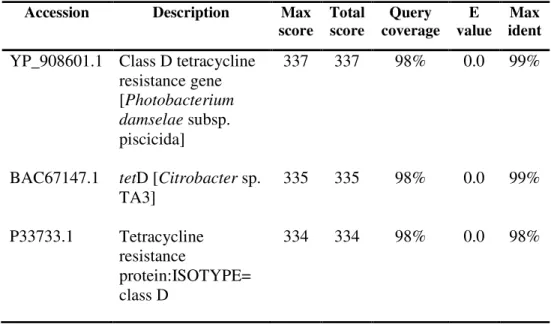
Overview
Bacterial strains
31 Escherichia coli, Acinetobacter baumannii and Klebsiella pneumonia are the top 3 widespread bacteria detected in this study. The high prevalence of Escherichia coli is consistent with the results of previous epidemiological studies, in which Escherichia coli was identified as an important pathogen frequently involved in both community and nosocomial infections (World Health Organization [WHO], 2002). It has been known as the most common causative agent of urinary tract infection (UTI) (Zieve, Juhn, & Eltz, 2009).
UTI is the second most common type of infection in the body, as well as the most common hospital-acquired infection (National Kidney and Urologic Diseases Information Clearinghouse, 2005; WHO, 2002). Escherichia coli can also cause nosocomial pneumonia and other diseases such as intra-abdominal infections, traveller's diarrhea and many others (Madappa & Go, 2010). As a result, the overuse of antibiotics against these agents has led to the development of antibiotic-resistant Escherichia coli (Knight, 1999).
In addition, infections caused by Escherichia coli resistance strains may also develop as a result of patients discontinuing antimicrobial therapy (Lepelletier, Caroff, Reynaud, & Richet, 1999). On the other hand, Acinetobacter baumannii and Klebsiella pneumonia made up another 14 and 11 of the tetracycline-resistant gram-negative bacteria. This observation appears to be in line with findings from previous studies, where Acinetobacter baumanni was the most frequently detected bacteria in hospital-acquired infections, while Klebsiella pneumonia also accounted for the high proportion of nosocomial infections (Tolmasky, Roberts, Woloj, & Crosa , 1986;Villegas & Hartstein, 2003).
Heavy use of antimicrobials against these two organisms has enhanced the selection and propagation of antibiotic-resistant strains in the hospital environment (Madigan, Martiko, Dunlap, & Clarks, 2009).
Age as a risk factor for infection
Template DNA extraction
Future Studies
The main objective of this study is to determine the prevalence of tetD and tetE genes among gram-negative clinical isolates resistant to tetracyclines in Malaysia using PCR rapid detection method. This study successfully sorted the distribution pattern of tetD responsible for tetracycline resistance seen in some clinical isolates, but failed to detect the presence of tetE in any of the samples. A low prevalence of tetD gene was detected among the tetracycline-resistant clinical isolates selected for this study.
Regarding tetE, no positive sample was detected among the 53 clinical isolates showing resistance to tetracyclines. The findings strongly suggest that other tetracycline resistance determinants, instead of tetD and tetE gene, are responsible for the tetracycline resistance in all the clinical isolates that tested negative for both genes. The bacteria in these clinical isolates may carry one of the other known tet genes or may have a novel gene.
Therefore, it is likely that tetD and tetE are not the dominant type of tetracycline resistance determinants in Malaysia. Frequency and distribution of tetracycline resistance genes in genetically diverse, unselected and non-clinical strains of Escherichia coli isolated from different human and animal sources. Susceptibility of Escherichia coli and Enterococcus faecium isolated from pigs and broilers to tetracycline degradation products and distribution of tetracycline resistance determinants in E.coli from food animals.
Antibiotic resistance and distribution of tetracycline resistance genes in Escherichia coli O157:H7 isolates from humans and cattle.
